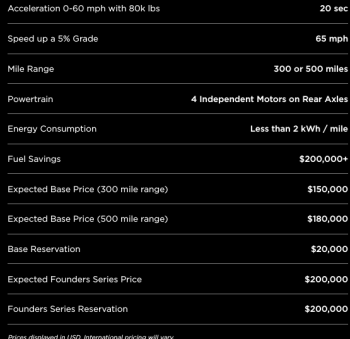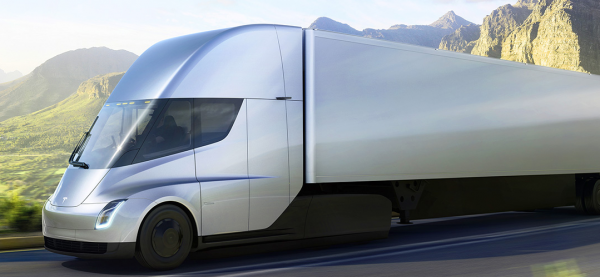Electric semi-truck may finally turn me into a Tesla fan-boi
Tesla electric semi-truck lowers operating costs by 20%, has superior torque for hauling loads up steep grades
While I respect Elon Musk, I’ve never been a fan-boi. Why? Because of the hype. The man has enough giddy middle-aged tech nerds who swoon at his every Tweet. And don’t get me started on all the Bloomberg New Energy Finances and clean tech sites that can’t get enough of him. But the Tesla electric semi-truck may finally convert me. This is the first Tesla electric vehicle that actually could provide a significant uptick in value over an internal combustion engine competitor (assuming the standard caveat that Tesla can actually deliver what it promised).
I can hear fan-boi heads exploding by the gross at that heretical argument. The logic, however, is on my side.
Let’s try a thought experiment to drive home my point by comparing a Tesla Model D that with potential US subsidies now costs $25,000 with a similarly priced ICE car, like a Mazda 6 or a Chevy Malibu.
What extra value does the Model D offer over its ICE competitors?
Nothing. The only real difference between the Model D and an ICE car is its fuel – electricity instead of gasoline.
The Model D performs exactly the same functions – grocery getting, driving the kids to soccer practice, etc. – without offering any extra value to the consumer.
I suppose you could argue that the Model D’s total cost of ownership will be lower than an ICE car, but when was the last time you noticed someone at an auto dealer banging away at their calculator to figure out those numbers?
Consumers get the most car possible for the lowest price possible. End of story.
And I also suppose the odd consumer might be lured to buy a Model D because of the EVs superior torque, which all gearheads will tell you is the quintessential benchmark for fun driving.
Or no tailpipe emissions, which appear to be far more highly prized by eco-activists and government environment department planners than by actual consumers.
Judging by the low EV sales numbers over the past 10 years, the no emissions argument holds little appeal for buyers, and the same can probably be said for the “cool factor.”
 In fact, those marginal benefits are more than offset by range anxiety, lack of model selection, market inertia, and many other constraints to adoption.
In fact, those marginal benefits are more than offset by range anxiety, lack of model selection, market inertia, and many other constraints to adoption.
The prima facie case for EV adoption constraints being much more powerful than the accelerators is simply that consumers aren’t buying. Global EV sales in 2017 were 775,000 and they will struggle to break 900,000 this year, around 20 per cent growth. Meanwhile, total global sales topped 88 million last year and are headed for another record in 2017.
For EV adoption to accelerate significantly – to double or triple sales every year, say – requires an exponential jump in value, such as super-batteries that get thousands of kilometres to a charge or widespread availability of Transportation as a Service, which RethinkX co-founder Tony Seba says will drop the cost per mile travelled in the United States by as much as a factor of 10.
As long as EVs do roughly the same thing for roughly the same price, growth will be steady but slow.
The Tesla electric semi-truck, on the other hand, does offer a big jump in value, in two areas.
The first is total cost of ownership. What has little appeal for the average consumer turns out to be a big deal for freight truckers in a highly competitive market working on thin margins. According to the US-based National Association of Small Trucking Companies, only 15 per cent of new trucking companies survive their second year of operation, mostly because of highly variable fuel costs and too much competition.
Tesla estimates energy consumption at less than two kilowatt hours per mile (according to the Environmental Protection Agency, 33.7 kilowatt-hours of electricity is equivalent to one US gallon of gasoline), for a fuel saving over the life of the truck of $200,000.
The MIT Technology Review calculated the Tesla semi-truck costs per mile at $1.26USD vs. $1.51 for traditional diesel models. Freight haulers average about 100,000 miles a year in the United States, which means that Tesla’s seemingly puny $.25/mile saving adds up to $25,000 a year per truck.
Musk says his truck will be 20 per cent cheaper to operate than his competitors.
The second significant benefit of the Tesla semi-truck is the big torque that comes with electric motors.
Tesla claims its truck accelerates from 0-60 mph in five seconds flat unloaded and 20 seconds when loaded with 80,000 pounds of goods. The average diesel semi-truck takes 15 seconds unloaded and 60 seconds loaded.
Tesla also says five per cent grades can be climbed at a speed of 65 mph. All you have to do is watch diesel trucks struggling up the steep hills of the Coquihalla highway in British Columbia, where grades range from 1.5 to 8.4 per cent, to understand the advantage the Tesla semi-truck would enjoy in hilly terrain.
The benefit to trucking companies of all that extra pulling power?
Time. Less time crawling up mountain roads translates into lower costs and, perhaps, more profits for a hard-pressed industry.
No wonder major retailers like Walmart and Loblaws, which maintain their own trucking fleets, were quick to reserve trucks for testing in the United States and Canada.
And let’s not forget what’s coming in the future. In past columns I’ve quoted my interview with Dr. Yi Cui, one America’s leading EV battery scientists, saying Lithium-ion batteries will become 50 per cent cheaper and gain 50 per cent more energy density over the next decade. If true, that would give the Tesla semi-truck an even greater advantage over diesel trucks.
Musk claims the Tesla semi-truck will soon feature full Level 5 autonomous driving, allowing platoons of trucks to travel together with just a single driver in the lead truck, saving even more money for owners.
Thus far, critics have sniffed at Tesla’s new product.
“The specs on the new semi truck and sports car would put both vehicles at the top of their segments…assuming they can be produced and sold as part of a sustainable business plan,” Karl Brauer, executive publisher of Kelley Blue Book and Autotrader, told Reuters.
“So far that final element has eluded Tesla Motors, which makes it difficult to see these vehicles as more than ‘what if’ concept cars.”
What they fail to understand is that, finally, Tesla has unveiled an electric vehicle that holds the potential to substantially increase value compared to internal combustion engines.
Greater consumer value drives faster adoption rates for new technologies. Someone should turn that truth into an inspirational poster and send it to Elon Musk as a Christmas present.
Therefore, one might ask Elon Musk why his company continues to tinker with Models S, X, and D – that offer consumers no real value uptick over ICE cars and that lose money on every unit – instead of focusing on the one product in the Tesla lineup that actually may offer greater value to users?
That pivot may turn me from a fan of the Tesla semi-truck into a fan-boi of the company.












Come on, now, we both know that some of the value over comparable ICE cars comes from the driving experience itself.
I used to think that Teslas ran on the smug self-satisfaction of their owners, but now I can see that these people are happy for a reason, lol! That’s value for you.
Great analysis on the unprecedented potential value of the semis. Maybe that headshot of Elon is the one you should put by your bedside now? 🙂